I’ll Show You How To Start a Blog in 2024: From Domains to Marketing
If you click to purchase a product or service based on our independent recommendations and impartial reviews, we may receive a commission. Learn more
Starting a blog can bring greater awareness to your business, generate more leads, and build trust with audiences when you share your industry expertise. But how can you swiftly build a website with a blog? You could use a website builder.
I’ve put together this comprehensive guide to help you start your blog. Below, I’ll delve into the key steps to follow, while sharing some additional tips that will help your blog grow, whether that’s choosing an effective domain name or joining an affiliate marketing program.
1. Decide What To Blog About
If you’re reading this, you likely have an idea of what you want to blog about already. However, before you dive headfirst into setting up your blog, it’s important to refine your ideas and find your niche online first.
Choosing a broad topic like fashion or fitness is great and all, but there are already a ton of fashion and fitness blogs out there. Instead, you need to be specific and narrow down these general topics until you find a niche. Here are a few examples to get you started:
- Into your health and fitness? – Consider fitness and wellbeing app reviews, athletic wear, best home workouts, healthy plant-based meals, or custom yoga routines.
- Passionate about beauty? – You could hone in on cruelty-free beauty, environmentally friendly products, Korean skincare, luxury reviews, or hair care based on a specific hair type (curly, straight, or in-between).
- Big on finance? – Niche blog ideas include discount shopping, money saving tips for college, retirement planning, financial tech news, or ethical investing.
My Tips on Identifying Your Blog’s Niche
Still struggling to decide? Here are a few factors to consider when choosing your blog’s niche:
- Think about your target audience – Only select a niche that your target audience will have an appetite for. After all, you won’t get many readers if they don’t care about what you’re writing about in the first place. You can see what’s popular with audiences by looking at trending topics via the news or social media platforms.
- Check out the competition – With a quick Google search, you can find other blogs operating in a specific niche. Look through their content and see if you can identify any gaps. How can you make your own blog posts even more useful?
- Identify your long-term goals – The niche you choose should be sustainable in the long run. Ask yourself if your chosen topic has the capacity to fulfill your goals in five years’ time. Does it have the scope to successfully inform, entertain, or sell to your audience?
2. Choose a Blogging Platform
So you’ve chosen a niche, but how can you bring your new blog to life? It’s time to turn to a website builder that’s suitable for your blog. You have a number of blogging platforms to choose from, but your final choice will come down to your budget, skills level, and website goals.
Setting up your blog will be slightly different depending on the platform you choose. For the sake of this guide, I’ve narrowed down two options: Wix and Squarespace. The two platforms were the best builders for blogging I’ve tested, and these examples will give you a good idea of what to expect when you first start out.
My Experience Blogging With Wix
Starting a blog with Wix was straightforward, since there were already plenty of industry-specific designs I could choose from. From Wix’s template page, I counted approximately 69 different blog templates in total.
This included designs across seven different categories: personal, food and travel, news and business, arts, fashion and beauty, sport and wellness, and podcast – that covers a lot of ground, making Wix a versatile option for small business blogs.
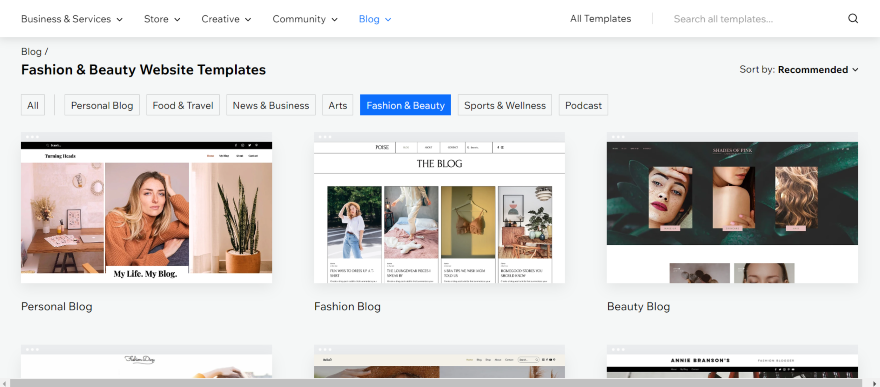
It’s also worth noting that Wix has an AI website builder if you want a blog website design that’s specifically tailored to your needs, which will take a few minutes to complete altogether. I messaged Wix’s AI bot and answered questions on my desired website. Then, it started loading up a unique design based on my answers.
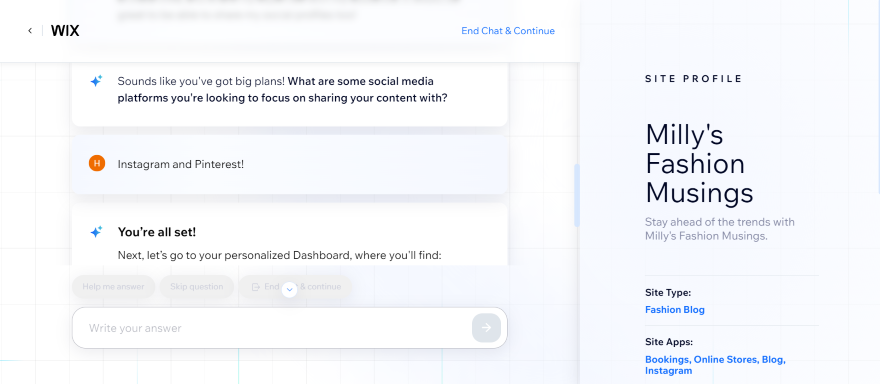
Despite the AI option, I ended up sticking to one of Wix’s ready-made blog templates instead, since I felt like these designs were already effective enough to cover my blog’s needs. I also thought that the AI bot was quite slow, with its questions and answers taking a while to load.
After choosing my base template, I explored Wix’s blogging features in the “Blog” section of my dashboard. Our testing shows that Wix offers the largest number of features on the market, so there were plenty for me to play around with:
- AI post creator – This tool can outline your blog posts for you, which is handy if writing isn’t your strong suit. It’ll generate blog titles, text, and images for you. However, I wasn’t blown away by the quality of the tool. The text felt a little artificial, while the imagery it generated wasn’t accurate. I recommended using the tool as a starting point only.
- Blog reports – You can find blog-specific analytics from your dashboard. This includes key metrics on your blog’s activity over time, your top posts, the traffic sources your site visitors are coming from, and how your email subscribers are engaging with blog notifications.
- Blogging guides – If you’re a blogging beginner, Wix has a blogging guide located in its Community Blog. It’s packed with resources on SEO, writing, design, and promotion.
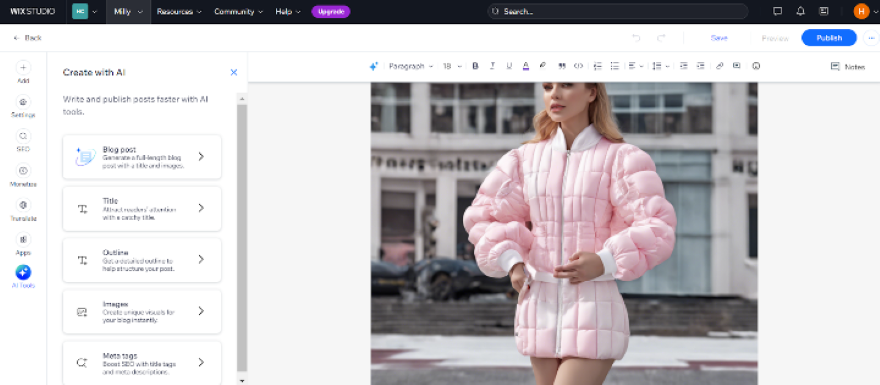
Which Wix Pricing Plan Is Best for My Blog?
I recommend the Light plan for personal blogs. For $17 per month (billed annually), Wix gives you 2GB storage space and 30 minutes of video storage – enough to get your blog going.
- For more information, refer to our guide to Wix’s Pricing
My Experience Blogging With Squarespace
After signing up to Squarespace, I could browse its template library and choose from around 50 blog templates. Similarly to Wix, I could choose between numerous industries like food and drink, fashion, health and wellbeing, and music.
Design-wise, I found that they have a slight edge over Wix’s selection. I’d recommended one of Squarespace’s templates if you want to find a clean, stylish design that will stun your readers, this builder is your best option.
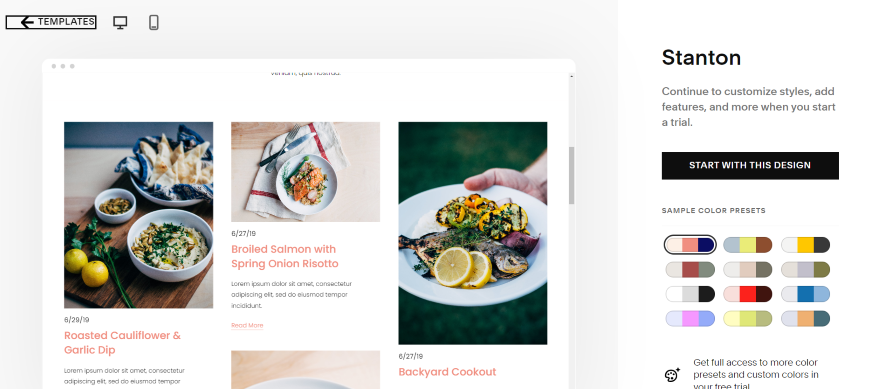
Besides the templates, Squarespace is also a great choice if you’re particular about your blog’s design. The drag-and-drop editor didn’t take long for me to get the hang of. I could easily drag different elements onto my website wherever I liked. When doing this, a gray grid outline also appeared on top of the editing screen which I could use to keep everything in place.
When I was happy with my website’s design, I took the time to check out Squarespace’s blogging features. Though these features aren’t as advanced as Wix’s, they did cover all of the basics. Here’s what stood out the most:
- Blog commenting – Squarespace lets you enable commenting on your blog posts. I recommended turning these on, since it’s an effective way to increase engagement with your audience. Make sure that you’re replying to comments to maintain positive relationships with your readers.
- Post scheduling – This is particularly useful if you’re creating content to a strict schedule, so you can make sure your work is published at the correct date and time each week.
- Blog categories and tags – You can organize your content by adding categories and tags to each blog post, helping readers find what they’re looking for on your website.
- Blog post SEO (search engine optimization) – This Squarespace SEO feature will improve your blog’s visibility on search engines. You edit each post’s SEO settings such as your meta title meta description which will show up in Google’s search results.
Which Squarespace Pricing Plan Is Best for My Blog?
Personal bloggers will want to opt for the Personal plan costing $16 per month (billed annually), which offers unlimited bandwidth, a free domain for your first year, and basic website metrics to track your blog’s performance via traffic sources, website views, and more.
- To learn more about its plans, refer to our Squarespace pricing guide.
3. Choose Your Blog’s Domain Name
Your domain name is how people will recognize your blog online, so you need to make it stand out. It’ll need to accurately reflect what you’re blogging about and be interesting enough for it to stand out from your competitors.
You have two ways to purchase a domain name: through the website builder you’re using, or through a domain name registrar like domain.com.
Website builders will often include domains in its plans. Take Wix for example. In all of its annual paid plans, you’ll receive a free domain for your first year, but there’s a catch. At renewal, the domain name is no longer free and you’ll have to pay a yearly fee to keep it. This can range between $20-$70 per year.
If you want to find a domain on a budget, then it’s worth looking into a domain name registrar instead. Domain.com is my main recommendation, since you’ll find good value deals on popular domain endings like “.com”, “.net”, and even “.blog”.
However, the price of these domain names do increase after one year. Don’t forget to check both the introductory price and the standard price before making a purchase.
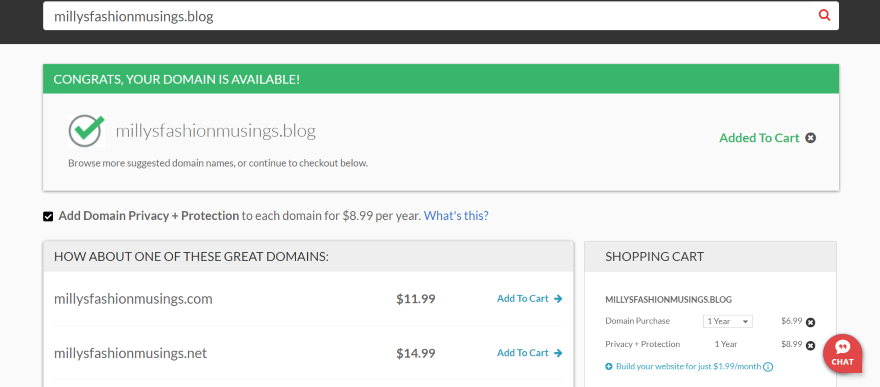
How Can I Choose a Strong Domain Name?
While you brainstorm and choose a domain name for your blog, keep these pointers in mind:
- Stay short and snappy – Your domain needs to be memorable and easy for people to type out without much difficulty, so keep it short. If possible, aim for a domain that’s between 6-15 characters.
- Keep it topical – Depending on your blog’s niche, you’ll want to feature keywords that are related to the content you’re covering. For instance, a cooking blog might use “cleancuisines.com,” “healthyeats.com,” or “fastfixrecipes.com”. If you’re struggling, you can check out GoDaddy Airo’s free AI Domain Search that will generate domain names based on a short prompt.
- Check social media too – You’ll most likely be using social media to promote your blog. Before you settle on a domain name, check and see if it’s available on the social accounts you want to use too. That way you can stay consistent on all platforms!
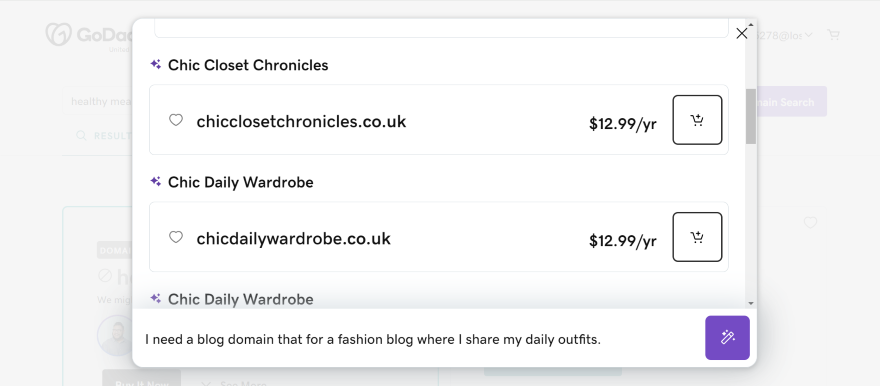
You could also find other ways to modify the domain, like adding a suffix or prefix (“myhealthyrecipes.com”), or playing around with the syntax (“recipesforhealth.com”).
4. Set Up Your Blog Website
With a platform and domain name at hand, it’s time to set up your blog website. Most website builders come with a template library you can select a responsive design from – often featuring a range of free or paid options depending on your budget.

I recommend choosing your blog’s template carefully, since you’ll want it to reflect your niche, have an eye-catching but clean design, and come with the exact features your blog needs. Here are a few features to look out for:
- Is it responsive? You’ll want your template to look good on a variety of devices and make it easy for website visitors to digest your blog’s content. Ensure your template is optimized for smartphones and desktops first.
- Does it reflect your branding? Though you can tweak your template’s design in the editor, make sure that the initial template you choose already encapsulates your unique brand personality. Take a close look at colors, fonts, and imagery. Is it a good representation of you and your content?
- Is it readable? If your blog is text-heavy, your website visitors will need to be able to clearly read your content. Ensure that your template has readable fonts and text that’s well-spaced.
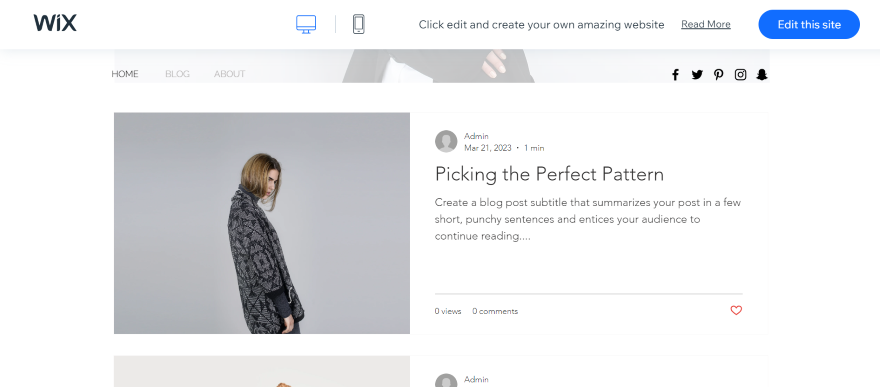
Once you’ve chosen a template, you’ll be able to edit it via your chosen platform’s editor. Most platforms come with a drag-and-drop editor that will keep this process streamlined.
You won’t need to worry about having any technical expertise either, since you can simply drag new content onto your website, whether that’s a sign-up form for your email list, social media buttons, a photo gallery, or video content.
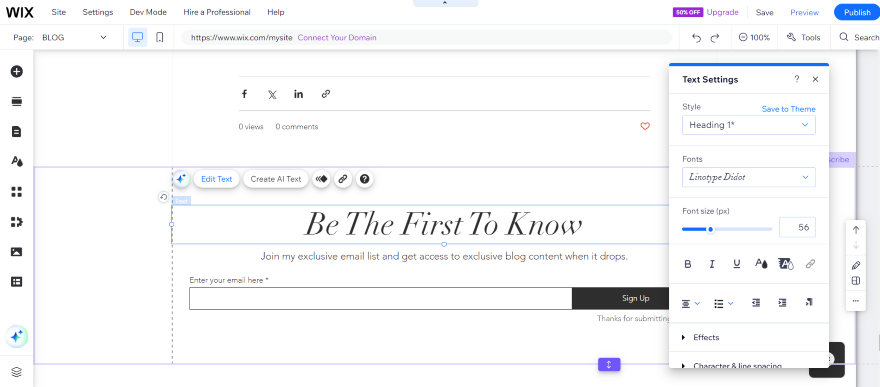
Use this time to tweak your blog’s design too. You’ll probably want to change your blog’s primary and secondary fonts, add your own imagery, and adjust the overall color scheme when finetuning your branding.
Which Pages Should I Add to My Blog Website?
Before you get stuck into writing your blog posts, you need to make sure that these core website pages are covered first:
- The “About” page: This page is essential, since it lets website visitors learn more about you and your blog. Don’t be tempted to write out an entire biography here. Instead, focus on a few sentences about your background, why you started your blog, and what your blog will cover – why should readers care?
- The “Contact” page: Keen to work with brands? Want to hear feedback from your readers? If so, you need an accessible “Contact” page that makes reaching out to you simple. Keep the contact form simple (three to four lines will do) and let people know how long you typically take to reply.
- A “Privacy Policy” page: To be transparent with your readers and take care of any legalities, you’ll want to add a “Privacy Policy” page to your blog. In a nutshell, a “Privacy Policy” page explains how your website collects and uses user data.
- A “Resources” page: If you want to monetize your blog, consider adding a “Resources” page too. This is where you’ll provide readers with valuable information on your niche and recommend relevant products or services that will serve their needs. It’s prime real estate for affiliate links (I’ll cover this later).
5. Plan and Write Your First Blog Posts
Because you’ve identified your niche, it should be easy to decide what blog ideas you want to churn out. Right? Well, before you come up with a huge list of ideas, you should narrow down the topics you want to write about into key categories first.
These categories will make your blog more digestible to users and help them find what they need. You don’t want them to feel overwhelmed by the amount of content on your page.
For instance, a healthy eating blog might split their content by:
- Time-specific categories: “breakfast recipes,” “lunch recipes,” and “dinner recipes.”
- Type of recipe categories: “air fryer recipes,” “slow cooker recipes,” and “oven recipes.”
- Dietary categories: “plant-based recipes,” “gluten-free recipes,” and “egg-free recipes.”
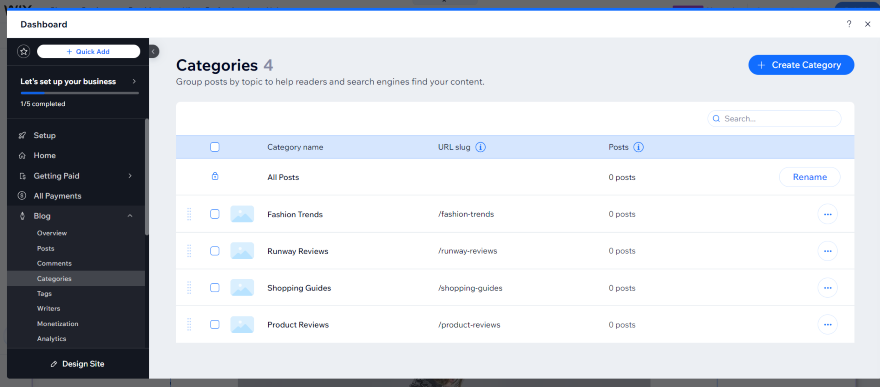
Once you’ve identified your blog’s key categories, you can start generating content ideas for each one that will appeal to your target audience. I’ll explore two ways you can do that below:
Keyword Research
Want to see which topics your readers are most interested in? Keyword research will help. This is when you identify the keywords that audiences are typing into Google, helping you gauge what’s popular. Once you’ve put together a list of relevant keywords, you can start building some blog post ideas around them.
To find these keywords, you need to use a keyword research tool like Semrush or Keyword Surfer. Some platforms, like Semrush, do require paid plans to access advanced features, but you do get 10 daily searches for free – more than enough for what you’ll need.
To start, open up your keyword research tool and type in a keyword related to your niche.
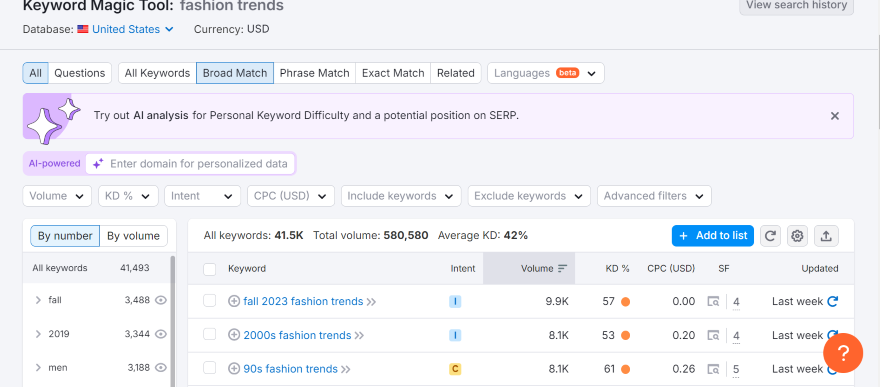
Once the tool has generated results, you’ll want to look for the search volume. If a keyword has a high search volume, it shows that a large number of people are searching for it online. For example, if you find that “healthy crockpot recipes” gets 18k searches per month, then you might want to create a crockpot recipe post due to its popularity.
Google Trends
On top of your keyword research, it’s worth having a look at Google Trends. This free tool shows you the most popular searches and is useful when creating topical blog posts that reflect current trends.
Using the tool is simple. All I had to do was type in the search term I wanted to analyze and click “Explore.” You’ll be left with useful metrics, such as interest in the search term over time and the regions it’s most popular in. The most useful section is “Related topics,” showing you popular terms related to your keyword.
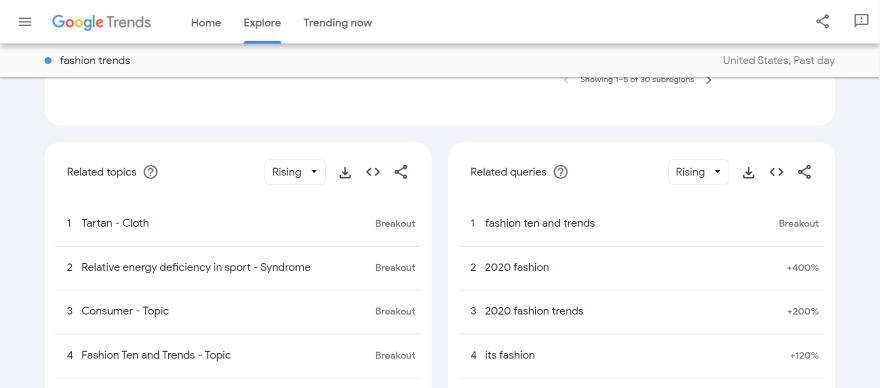
Afterwards, note down the relevant keywords you’ve found from both keyword research and Google Trends. You can start putting together a list of post ideas based on your findings.
Once you’ve created a list of ideas, it’s time to start organizing them with a content calendar.
How Should I Create a Content Calendar for My Blog?
Your content calendar is where you’ll organize and schedule your blog posts. It’s important to create one if you’re posting regularly each week, since it’ll help you post according to schedule once you’ve batched your content beforehand.
You don’t need any fancy software to create a content calendar. A Google Sheets calendar will do, but you could also use a free project management tool like Notion if you want something more streamlined. On your calendar, you’ll want to feature:
- Article titles – The name of each blog post you have coming up
- Article descriptions – A brief description of what each article contains
- Important dates – This includes any due dates for drafts and publishing
- Seasonal or topical dates – You could put down key dates related to your industry to help you come up with seasonal or topical content. For instance, if you run a sports blog, you could put down key events like the SuperBowl, Olympics, or World Cup
- Social posts – If you’re making social media content alongside your blog posts, you could also use your content calendar to record when you’re going to publish them
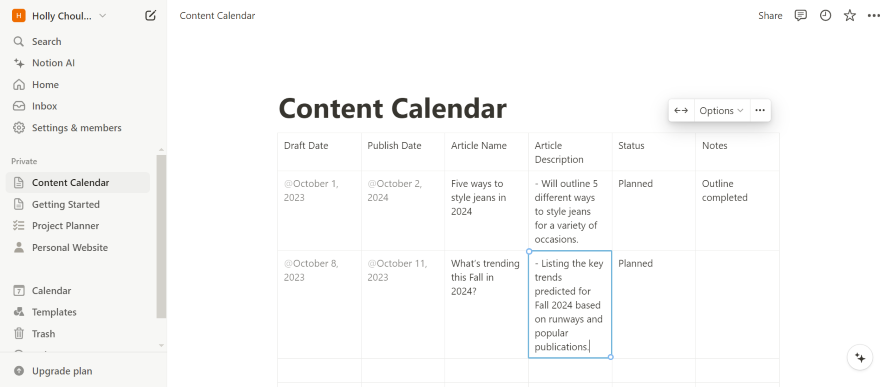
Now that you’re armed with a fresh set of ideas and an organized calendar, you can start writing your blog posts and publishing your first bits of content – enjoy!
When writing, remember to split your content up with readable headings (H1s, H2, etc), white space, short paragraphs, and eye-catching imagery. This will make sure that your blog posts are enjoyable for website visitors to read from start to finish.
6. Start Marketing Your Blog
Once your first post is published, you can make sure that your brilliant ideas are seen by a wider audience. By making an effort with your content marketing strategy, you’ll be able to grow your blog’s traffic and reach different online communities. Here are a few ways to start:
- Social media – Your social media strategy will include the key channels you want to promote your blog on, which could include Instagram, Pinterest, Facebook, or TikTok. When creating social media accounts, choose platforms that are popular with your target audience. For example, if you run a photography blog that showcases your works, Pinterest would be a good fit due to how visual the platform is.
- Email marketing – You could also consider sending weekly or monthly emails to your email list. It’s another way to engage your audience through business updates, sneak peeks, or other original content. Most website builders enable you to add sign up forms to your website, so you can collect emails directly from your blog.
- Guest posting – Consider guest posting on another website or blog for more exposure. You’ll need to reach out to a website owner in a similar niche and pitch a content idea for their website and why it’ll benefit them. If you get the green light, you can use this opportunity to reach wider audiences and even gain a link back to your blog, increasing your site’s traffic and domain authority in the process.
What About My Blog’s SEO? (Search Engine Optimization)
Before moving on, you need to make sure that your website and blog posts are SEO optimized. This will increase the likelihood of your posts appearing in Google’s search results. The website builders I’ve mentioned allow you to tweak your website’s SEO, so here are a few basics to have covered:
- Meta titles and meta descriptions – Your meta title and description is what’s shown when your page appears in search results. Check that you have a targeted keyword in both of them.
- Alternative text – This is when you describe the contents of the imagery on your website. Not only does it help Google crawl your website, but it makes your pages more accessible for visually impaired users.
- Compressed images – Website speed can also impact SEO. An easy way to optimize images is by compressing them, consequently speeding up your website’s loading times.
- Mobile optimization – Google puts mobile websites first, so make sure that your blog works well on mobile devices too. Check that your content is formatted clearly, nothing is hidden on the screen, and that any buttons are clickable.
- Internal links – These are used to link between different pages on your website. They also help Google understand your website’s structure and get new pages indexed in search results.
This isn’t an exhaustive list, so be sure to do some additional research first. Thankfully, we do have another list filled with our top blog SEO tips that go into more detail.
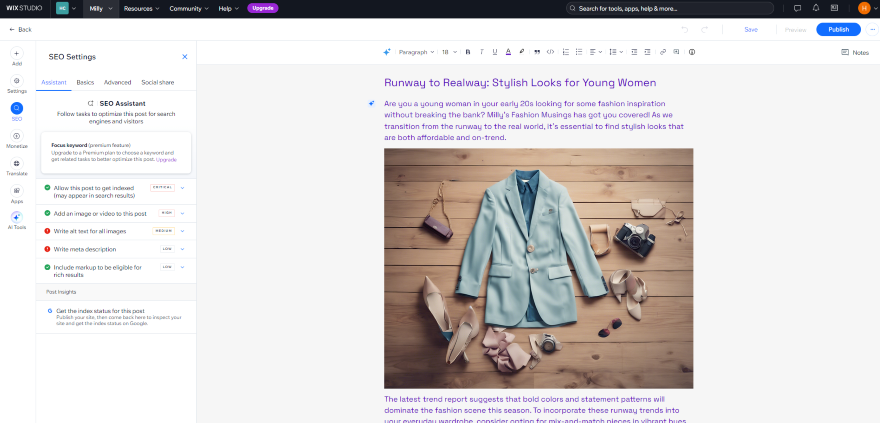
7. Monetize Your Blog
This next step is optional depending on your blog’s goals, but if you do want to make some extra cash from your blog, I’ve identified two ways you can:
Affiliate Marketing
Affiliate marketing is a great way to earn a passive income. It works like this: you promote a company’s product or service on your blog with a link, receiving a small commision if a reader clicks on this link and makes a purchase.
To get started, you’ll want to find an affiliate marketing program that’s in your blog’s niche. Some of the biggest brands – like Amazon, Target, and eBay – offer affiliate partnerships, so it’s worth checking out what they offer too. Commission rates will differ depending on your industry, though you’ll find rates anywhere between 5% to 25%.
Once you’ve found an affiliate program you’re compatible with, you need to apply. During the process, you’ll likely be asked for your blog’s URL, any additional social media accounts, a description of the kind of content you create, and key metrics on your website’s traffic.
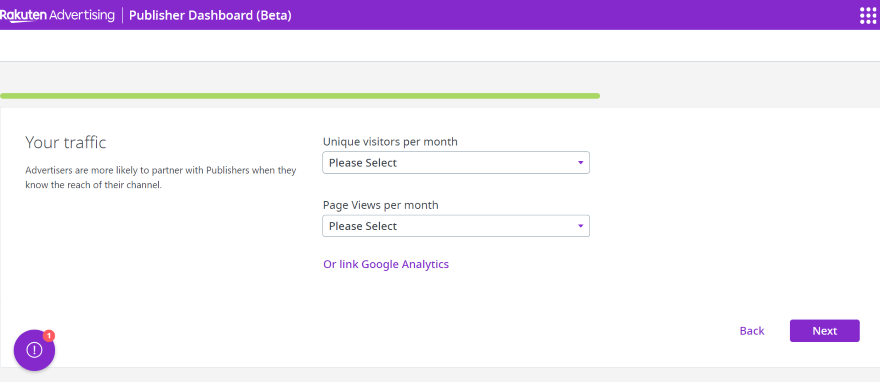
If you’re accepted, congratulations! But the work doesn’t stop there. To make the most out of these links, you need to create high-quality content that will be useful to your target audience.
Don’t just stuff a large number of links into your content. Actually test out the products or services yourself. You could do a review blog post on a product with photos of you using it, or help stressed shoppers out by featuring some affiliate links in a seasonal gift guide.
As you create great content and gradually build your website’s traffic, these links could help you earn some extra cash in the long run.
Sponsored Posts
On top of affiliate marketing, you could also collaborate with other companies and create sponsored blog posts.
The best way to do this is by identifying relevant brands in your niche and reaching out to them. When pitching to a brand via email, briefly explain who you are, introduce your blog, and explain how your content can bring traffic to their website. If you have any stats measuring your blog’s success, mention those too.
In response, some brands may ask you for a media kit, a document that outlines your company’s story, branding, key information about your blog and its audience (you can include important metrics here), and the rates you charge per blog post.
If you want to create a media kit for brands, I recommend using a free graphic design software like Canvas. When looking through its templates, I found some free and customizable designs that would be suitable for the task.
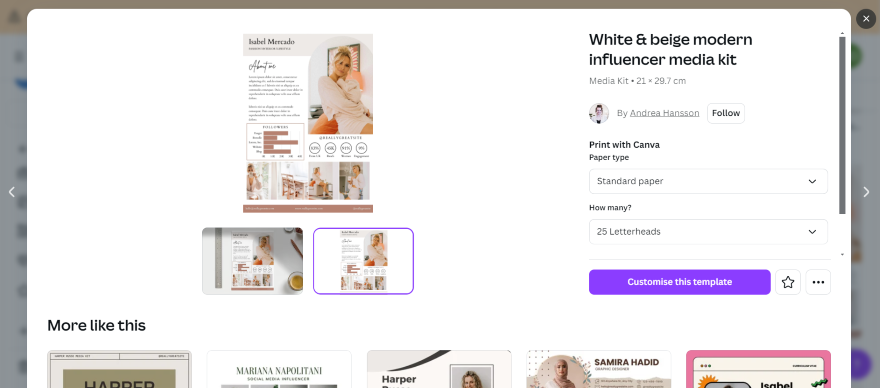
Be aware that when you publish a sponsored post, you need to make it clear that you’re advertising a product or service for another company. This is a legal requirement. Clearly explain, in a sentence or two, that it’s a gifted product of service in your post. Doing so will also help you build trust with your audience.
How To Start A Blog: Conclusion
Have content that’s useful to your target audience. Each blog post you write should keep their needs in mind. What are their pain points? Can your writing make their life easier?
- Have content that’s useful to your target audience. Each blog post you write should keep their needs in mind. What are their pain points? Can your writing make their life easier?
- Be visually cohesive. Ensure that your blog’s design, from the visuals you use to the fonts you pick, provide readers with a pleasant user experience. Recognisable branding will help your blog stand out online and keep readers coming back for more.
- Correlate with your marketing efforts too. If you want to grow online, you can’t forget to market your blog posts. Use social media, email marketing, guest posting, and SEO best practices to your advantage. You could use your content calendar to coordinate blog and social media posts in advance.

4 comments